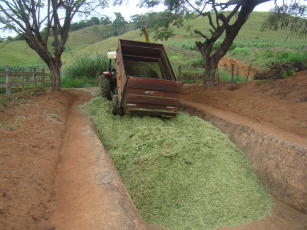Silage of elephant grass BRS Capiaçu for lactating cows
Silage of elephant grass BRS Capiaçu for lactating cows

Photo: PEREIRA, ANTONIO VANDER
In intensive milk production systems, planning roughage supplementation is critical to the success of the activity. In Brazil the main forage conservation strategy is ensilage, in which maize is the main crop used, due to its high ensilability and silage nutritive value. However, the oscillation of input prices (fertilizers, pesticides, seeds, etc.) has increased the production costs of such crop, a fact that has been pointed out by farmers as a barrier for the economic viability of the production systems. Added to the economic factor is the risk of increasingly frequent and longer Indian summer periods, which contribute to significant losses to maize cropping and, to a lesser extent, sorghum crop, which is the second most used silage crop. In addition to these two crops, sugarcane ( Saccharum officinarum L.) is also widely used in feeding the herds, mainly in the dry season, either fed fresh or ensiled, having as main limiting factors low protein levels and low digestibility of fiber. The use of tropical grasses, mainly the genus Brachiaria, Panicum and Pennisetum, has been advocated as an alternative to roughage supplementation, with the aim of reducing production costs and preventing losses due to climatic variations. Among these, elephantgrass ( Pennisetum purpureum Schum.) has excellent potential for silage, in view of its high biomass production and good nutritive value. However, tropical grasses are characterized by low levels of dry matter (DM) and soluble carbohydrates, which can impair the fermentation process and increase effluent-caused losses. Elephantgrass cv. BRS Capiaçu, recently released by Embrapa, appears to have good ensilability. This cultivar is characterized mainly by the high production of dry matter, which contributes significantly to the reduction in production costs. In addition, it has good resistance to water stress (Indian summer periods), good nutritive value, and characteristic of regrowth that can favor the silage process, considering that it can be cut to 50 cm of the soil, without aerial tillering, with solely the occurrence of basal tillers, which may allow the ensilage of material of better nutritive value and with a higher dry matter content. This study focuses on the following aspects: to study the agronomic and productive characteristics of the cultivar BRS Capiaçu and to define the best combination of cutting frequency / stubble height for the production of biomass for ensiling; to evaluate the fermentation profile and nutritive value of BRS Capiaçu silage; to evaluate the effect of the inclusion of BRS Capiaçu silage in the diets on the performance of lactating cows, based on nutrient intake, milk production and composition, body weight variations, energy expenditure, and blood metabolic parameters; and to study the economic viability of the use of BRS Capiaçu silage as a replacement for the silages traditionally used to feed lactating cows. The following results are expected: to define the ideal cutting management, in order to obtain the best biomass production: dry matter content: nutritive value ratio for ensiling; to define the best level of inclusion of BRS Capiaçu silage in the diet as a replacement for corn silage for lactating cows; and to evaluate the economic viability of the use of BRS Capiaçu silage in lactating dairy cows diet. The information generated will contribute to complement the technological package, with adjustments in BRS Capiaçu silage cutting management and the inclusion of BRS Capiaçu silage in the diets, with a focus on reducing production costs and increasing the competitiveness of milk production systems.
Status: Completed Start date: Tue Aug 01 00:00:00 GMT-03:00 2017 Conclusion date: Fri Jul 31 00:00:00 GMT-03:00 2020
Head Unit: Embrapa Dairy Cattle
Project leader: Mirton Jose Frota Morenz
Contact: mirton.morenz@embrapa.br
